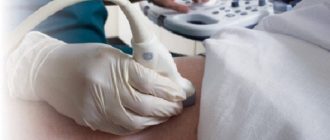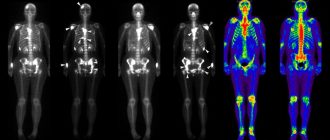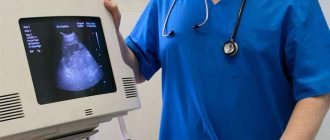TRUS of the prostate gland is a universal diagnostic examination for studying possible pathologies of the organ. The principle of the procedure is no different from a regular ultrasound, except that the sensor is inserted rectally, which allows you to obtain more accurate data on the size and condition of the gland. The procedure is preceded by a short preparatory period, the rules for which may differ depending on the purpose of the examination. The procedure is painless and takes about 20 minutes.
Why is TRUS performed?
TRUS of the prostate gland is done to confirm or rule out inflammation (prostatitis), benign (adenoma) or malignant (cancer) tumors. In the case of tumor diseases, the examination will not be definitive, but will help to better understand the pathological processes taking place in the organ.
TRUS of the prostate shows:
- Anteroposterior and superior-inferior dimensions.
- Shape and contours.
- Volume and symmetry.
- Presence of a median lobe.
- Vas deferens.
- Size and structure of seminal vesicles.
- Echogenicity of various areas.
- The structure of the peripheral and central zones.
In addition to these parameters, the TRUS procedure helps to detect stones in the gland, tissue fibrosis and abnormalities in the structure of the organ.
Comparison of TRUS with conventional ultrasound
Transrectal ultrasound of the prostate gland is a type of ultrasound examination. However, in the case of prostate testing, it has the following advantages:
- the transrectal ultrasound method better diagnoses minor structural changes and provides more detailed information about the condition of the tissues;
- more accurately shows the size of the gland and its areas;
- Transrectal ultrasound of the prostate allows one to study the condition of the seminal vesicles, which is not possible with conventional ultrasound.
Disadvantages include negative emotions and physical discomfort of the patient.
Indications
TRUS analysis of the prostate is indicated for all men over 40 years of age as a routine examination. It is recommended to do it once a year; in case of previous acute inflammation or the presence of chronic prostatitis - once every six months.
Transrectal ultrasound is indicated for the following symptoms:
- painful sensations in the groin and perineum;
- frequent urge to urinate, weak stream of urine, discharge from the urethra;
- pain after urination or ejaculation;
- presence of blood in semen;
- deterioration of potency;
- suspicion of infertility;
- an increased level of the dog or the dynamics of its growth from the previous analysis, the ratio of the free dog to the total is outside the norm;
- detection of an enlarged gland or the presence of compactions upon palpation.
TRUS can be done as often as necessary, given that the examination does not cause complications and does not use X-rays.
Contraindications
Contraindications for TRUS are as follows:
- exacerbation of hemorrhoids;
- proctitis or paraproctitis (inflammation of the rectum);
- damage to the anus;
- after surgical removal of part of the rectum;
- in the presence of a perirectal fistula;
- exacerbation of prostatitis;
- diarrhea.
In critical situations, the procedure can be prescribed by a doctor, regardless of the presence of contraindications.
Preparation for TRUS
Transrectal ultrasound of the prostate gland, unlike conventional ultrasound, requires preparation for the examination.
You need to prepare for a transrectal ultrasound of the prostate at home, 3 days before the procedure.
Preparation for TRUS of the prostate and bladder includes:
- Diet.
- Refusal of medications.
- Purgation.
- Bladder filling.
Diet
First of all, you need to change your diet. It is necessary to avoid foods that promote gas formation in the intestines - cabbage, legumes, flour products. You should also avoid alcohol and carbonated drinks. The examination is carried out on an empty stomach, 12 hours before the examination you should refuse to eat. If the examination is carried out in the afternoon, dinner should be no later than 20:00, and a light breakfast is allowed on the morning of the examination.
Refusal of medications
Preparation for the study includes avoiding anticoagulants (including Aspirin), because blood thinning distorts the results of transrectal ultrasound of the prostate. If it is impossible to refuse to take it, you should discuss this with your doctor, and it is possible to prescribe analogues.
Purgation
There are 3 ways to cleanse the intestines before TRUS of the prostate:
- Take a laxative beforehand. The time for taking a laxative is calculated depending on the drug used.
- Do an enema before TRUS of the prostate at home or immediately before diagnosis.
- Use a microenema or glycerin suppository, for example, Microlax. After a short time, the urge to defecate will appear, after which it will be possible to undergo examination.
Bladder filling
Drinking before a transrectal ultrasound is necessary depending on the purpose of the study. If you have decreased potency, suspected infertility, or elevated PSA levels, you should drink about a liter of water an hour before the procedure. You cannot go to the toilet before the procedure. If you suspect prostatitis, you should drink 1.5 liters of water 30 minutes before the examination. If necessary, diagnostics can be carried out twice - before going to the toilet and after, which will give a better idea of the condition of the bladder.
In both cases, it is necessary to drink pure still water.
How is TRUS performed?
Transrectal ultrasound is performed as follows:
- The patient is placed on his left side on the couch, with his legs pressed to his stomach. This position provides the most comfortable access to the rectum.
- TRUS of the prostate gland is performed using an endoscope with a special sensor. The device is inserted into the rectum to a depth of 5-6 cm.
- The device is first covered with a sterile film and lubricated with gel, which eliminates discomfort during its insertion.
- The technique involves examining the gland from different angles. To do this, the image is fixed in several planes to study longitudinal and transverse images of the gland, from which it becomes possible to estimate its size and other parameters.
TRUS takes about 20-30 minutes, the first results can be reported already during the examination.
Interpretation of TRUS results
As a result of the survey, the following factors are analyzed:
- Gland size. Normally, its length is 22-40 mm, width 23, thickness 43 mm. Volume – 200-280 mm 3 . For a more accurate assessment, you can multiply the patient's age by 0.13 and add 16.4.
- Contours in normal condition are smooth and clearly visible. Fuzzy contours combined with increased size and increased echogenicity indicate chronic prostatitis.
- The normal shape of the organ is semicircular or triangular.
- Normal echogenicity is average. A low indicator indicates acute prostatitis, anechoicity indicates cysts, and hyperechogenicity indicates stones.
- The structure of a healthy gland is heterogeneous and fine-grained.



